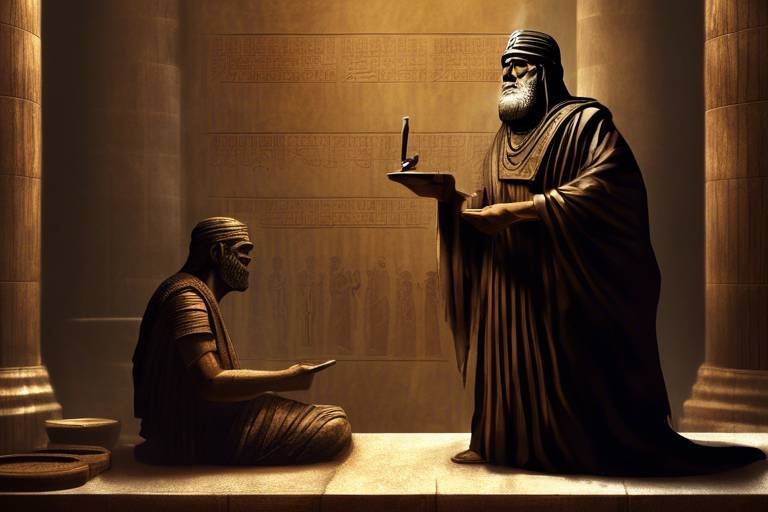Hammurabi and the Origins of Law
When delving into the historical tapestry of legal systems, one cannot overlook the monumental figure of Hammurabi and his enduring legacy on the origins of law. The roots of modern legal frameworks trace back to the ancient Babylonian king's groundbreaking Code, a pioneering set of laws that reshaped the concept of justice and governance.
Hammurabi, a formidable ruler of the Babylonian Empire, left an indelible mark on history with his visionary approach to law and order. His reign was characterized by a relentless pursuit of justice and equity, as he sought to establish a society governed by principles of fairness and accountability. Through his military campaigns and administrative prowess, Hammurabi solidified his position as a transformative leader in the ancient world.
The essence of Hammurabi's Code lies in its meticulous structure and unwavering commitment to upholding societal norms. Engraved on a stele for all to see, the Code encapsulated a comprehensive set of laws that governed various aspects of daily life, from commerce to family matters. Its impact reverberated throughout Babylonian society, setting a precedent for legal systems to come.
One of the defining features of Hammurabi's Code was its emphasis on proportional justice, famously encapsulated in the principle of "an eye for an eye." This concept of retributive justice underscored the importance of accountability and deterrence, laying the groundwork for future legal practices. Moreover, Hammurabi's establishment of standardized legal procedures set a new standard for legal administration, ensuring consistency and fairness in the application of laws.
As the cornerstone of social order in ancient Babylon, Hammurabi's Code played a pivotal role in maintaining stability and harmony within the empire. By addressing a wide array of offenses and prescribing appropriate punishments, the Code served as a deterrent against wrongdoing and a beacon of justice for the populace. Its influence extended far beyond the borders of Babylon, shaping the evolution of legal systems across civilizations.
The enduring legacy of Hammurabi's Code transcends time and geography, leaving an indelible mark on the development of legal principles worldwide. Elements of the Code continue to resonate in modern concepts of justice, serving as a testament to Hammurabi's enduring impact on the evolution of legal thought. Through a comparative analysis with contemporary legal systems, one can appreciate the timeless relevance of Hammurabi's contributions to the fabric of law and governance.
In reflecting on Hammurabi's legal legacy, one is confronted with the profound historical significance of his contributions to the evolution of legal principles and systems. His Code stands as a testament to the enduring quest for justice and fairness in human societies, encapsulating the timeless ideals of accountability and equity. As we navigate the complexities of modern legal frameworks, we are reminded of the enduring legacy of Hammurabi and the enduring relevance of his ancient wisdom.

Life and Reign of Hammurabi
Life and Reign of Hammurabi: King Hammurabi, a prominent figure in ancient Mesopotamian history, ascended to power in the 18th century BCE, establishing the Babylonian Empire in the region of Mesopotamia. Known for his military prowess and strategic acumen, Hammurabi expanded his empire through successful military campaigns, bringing various city-states under his rule. His reign marked a period of significant cultural and political development in the region, with Babylon becoming a center of trade, commerce, and intellectual exchange.
Under Hammurabi's leadership, Babylon flourished as a prominent city, renowned for its architectural achievements and administrative innovations. The king's governance was characterized by a strong emphasis on justice and order, reflected in his famous legal code, which sought to regulate various aspects of society and ensure fairness in the application of laws.
Despite facing challenges from neighboring kingdoms and internal dissent, Hammurabi's rule was marked by stability and prosperity, with his empire reaching its zenith during his reign. His legacy as a wise and just ruler continues to endure through the centuries, shaping the course of legal and political thought in ancient Mesopotamia and beyond.

Hammurabi's Code: An Overview
Exploring the historical significance of Hammurabi's Code and its influence on the development of legal systems. Learn about the ancient Babylonian king's contributions to the concept of justice and governance.
Discover the background and accomplishments of King Hammurabi, including his rise to power, military campaigns, and establishment of the Babylonian Empire. Learn about the cultural context in which he ruled.
Hammurabi's Code, dating back to around 1754 BC, is one of the earliest known sets of laws in human history. Engraved on a stele, it consists of 282 laws covering various aspects of daily life, including family, property, commerce, and crime. The code follows the principle of "an eye for an eye" and reflects Hammurabi's aim to establish justice and order in his kingdom.
Understanding the concepts of justice, equity, and punishment as outlined in Hammurabi's Code. Delve into the specific laws related to various crimes and the corresponding punishments prescribed by the code.
Examining the innovative legal practices introduced by Hammurabi, such as the concept of "an eye for an eye" and the establishment of standardized legal procedures. Learn how these innovations shaped future legal systems.
Exploring the role of Hammurabi's Code in maintaining social order and stability within ancient Babylonian society. Analyze how the laws addressed various aspects of daily life and interpersonal relationships.
Tracing the enduring legacy of Hammurabi's Code in the development of legal systems around the world. Discover how elements of the code have influenced modern concepts of justice, fairness, and rule of law.
Comparing and contrasting Hammurabi's Code with contemporary legal frameworks. Explore the similarities and differences in the principles, procedures, and objectives of ancient Babylonian law and modern legal systems.
Reflecting on the historical significance of Hammurabi's contributions to the evolution of legal principles and systems. Consider the lasting impact of his code on the development of civilization and governance.
Stay tuned for answers to common questions about Hammurabi's Code and its impact on legal history.

Justice and Punishment in Hammurabi's Code
Exploring the historical significance of Hammurabi's Code and its influence on the development of legal systems. Learn about the ancient Babylonian king's contributions to the concept of justice and governance.
Justice and punishment were fundamental aspects of Hammurabi's Code, reflecting the societal values and norms of ancient Babylon. The code encompassed a wide range of laws that outlined specific crimes and their corresponding punishments, aiming to maintain order and fairness in the kingdom.
One of the key principles of Hammurabi's Code was the concept of "an eye for an eye," emphasizing retribution and proportional punishment for crimes committed. This principle aimed to ensure that the punishment fit the crime, promoting a sense of equity and deterrence in the society.
The code prescribed different penalties for various offenses, ranging from fines and restitution to more severe punishments like amputation or death, depending on the severity of the crime. By clearly defining the consequences of unlawful actions, Hammurabi's Code sought to deter wrongdoing and uphold the rule of law.
Moreover, the code established guidelines for resolving disputes and seeking justice, providing a framework for legal proceedings and ensuring that cases were adjudicated fairly and impartially. It laid the foundation for a structured legal system that prioritized accountability and adherence to established laws.
Overall, justice and punishment in Hammurabi's Code were integral to maintaining social order and harmony in ancient Babylon, setting a precedent for the importance of law enforcement and judicial processes in a civilized society.
1. What was the significance of Hammurabi's Code in ancient Babylonian society?
2. How did Hammurabi's Code influence the development of legal systems in other civilizations?
3. What were some of the key principles and punishments outlined in Hammurabi's Code?
4. How does Hammurabi's concept of "an eye for an eye" compare to modern legal principles?

Legal Innovations of Hammurabi
King Hammurabi was not only a powerful ruler but also a visionary when it came to legal innovations. One of his most notable contributions was the introduction of the concept of "an eye for an eye," which laid the foundation for the principle of proportionate justice. This revolutionary idea ensured that punishments were directly linked to the severity of the crime committed, promoting fairness and deterrence in society. Additionally, Hammurabi established standardized legal procedures, bringing consistency and predictability to the legal system. By codifying laws and procedures, he set a precedent for organized and systematic governance that would influence future legal systems.

an eye for an eye
One of the most well-known principles of justice found in Hammurabi's Code is the concept of "an eye for an eye." This principle, also known as lex talionis, dictates that the punishment should be equivalent to the crime committed. In the context of ancient Babylonian law, this meant that if someone caused harm to another person, they would receive a punishment that mirrored the harm inflicted.
This concept was not just about retaliation but also about ensuring fairness and balance in the legal system. By holding individuals accountable for their actions and imposing punishments that directly related to the offense, Hammurabi aimed to establish a sense of justice and deterrence in society. The idea was to prevent individuals from committing crimes by making them face consequences that were proportional to their actions.
Furthermore, "an eye for an eye" served as a deterrent against excessive punishment or retribution. It set clear boundaries for acceptable behavior and provided a framework for resolving disputes and conflicts. This principle was a key component of Hammurabi's efforts to maintain order and harmony within his kingdom, as it promoted a sense of accountability and responsibility among the populace.
While the concept of "an eye for an eye" may seem harsh by modern standards, it was a groundbreaking development in the history of legal systems. It laid the foundation for the idea of proportionate justice and influenced the evolution of legal principles in civilizations across the world. By emphasizing the importance of equitable retribution, Hammurabi's Code set a precedent for the concept of justice that continues to resonate in contemporary legal frameworks.

and the establishment of standardized legal procedures. Learn how these innovations shaped future legal systems.
When it comes to Hammurabi's legal innovations, one cannot overlook the significance of his establishment of standardized legal procedures. This pioneering move laid the foundation for a more systematic and organized approach to justice, setting a precedent for future legal systems to follow. By introducing standardized procedures, Hammurabi ensured that the application of laws was consistent and fair, promoting transparency and accountability within the legal framework. These innovative practices not only streamlined the administration of justice but also contributed to the overall efficiency of the legal system.

Hammurabi's Code and Social Order
When examining Hammurabi's Code in the context of social order, it becomes evident that the laws established by the ancient Babylonian king played a crucial role in maintaining stability and structure within the society of that time. The code encompassed a wide range of regulations that governed various aspects of daily life, from trade and commerce to familial relationships and property rights. By clearly outlining the rights and responsibilities of individuals, Hammurabi's Code served as a framework for promoting harmony and resolving conflicts in a fair and systematic manner.
One of the key aspects of Hammurabi's Code that contributed to social order was its emphasis on justice and equality. The laws were designed to ensure that all members of society, regardless of their status or wealth, were held accountable for their actions and treated fairly under the law. By establishing clear guidelines for behavior and consequences for violations, the code helped to prevent disputes and maintain a sense of order within the community.
Moreover, Hammurabi's Code addressed issues related to property rights, contracts, and personal injury, providing a legal basis for resolving conflicts and protecting the interests of individuals. The code also outlined specific punishments for crimes and offenses, serving as a deterrent against misconduct and promoting adherence to societal norms.
By establishing a set of laws that applied to all members of society, Hammurabi's Code fostered a sense of unity and cohesion among the people of ancient Babylon. It provided a common understanding of acceptable behavior and consequences, which helped to reduce ambiguity and promote cooperation among individuals. In this way, the code played a vital role in shaping the social fabric of Babylonian society and ensuring the smooth functioning of daily life.

Legacy of Hammurabi's Code
The legacy of Hammurabi's Code extends far beyond the ancient Babylonian society in which it originated. This ancient legal document, carved into a stele nearly 4,000 years ago, has left an indelible mark on the development of legal systems worldwide. Its influence can be seen in the fundamental principles of justice, fairness, and accountability that form the bedrock of modern legal frameworks.
One of the most enduring aspects of Hammurabi's Code is its emphasis on the concept of justice being rooted in the idea of equity. The code sought to establish a sense of balance and proportionality in meting out punishments for crimes, reflecting a belief in the importance of fair treatment for all members of society. This emphasis on equity continues to resonate in contemporary legal systems, where the pursuit of justice remains a guiding principle.
Furthermore, Hammurabi's Code introduced the concept of legal accountability by prescribing specific punishments for different offenses. This notion that individuals should be held responsible for their actions laid the foundation for the modern legal principle of individual liability, where individuals are held accountable for their conduct under the law.
The legacy of Hammurabi's Code also includes its role in shaping societal norms and values. By codifying laws that governed various aspects of daily life, such as commerce, marriage, and property rights, the code contributed to the establishment of a more ordered and structured society. This emphasis on social order and stability has had a lasting impact on the development of legal systems worldwide.
Moreover, the principles of consistency and transparency embedded in Hammurabi's Code have influenced the evolution of legal procedures and practices. The code's emphasis on clear and standardized legal processes set a precedent for ensuring due process and fair treatment in legal proceedings, principles that remain central to modern legal systems.
In essence, the legacy of Hammurabi's Code can be seen in the enduring values of justice, equity, accountability, and social order that continue to shape legal systems around the world. By examining the historical context and impact of this ancient legal document, we gain a deeper understanding of the evolution of legal principles and the enduring legacy of one of the earliest known codes of law.

Comparative Analysis with Modern Legal Systems
When comparing Hammurabi's Code with modern legal systems, it becomes evident that despite the vast temporal and cultural differences, there are intriguing parallels and divergences to explore. One of the fundamental similarities lies in the overarching goal of establishing and maintaining societal order through a structured set of laws and regulations. Both ancient Babylonian law and contemporary legal frameworks aim to uphold justice, protect individual rights, and deter unlawful behavior.
However, a notable difference arises in the approach to punishment and retribution. While Hammurabi's Code famously embodies the principle of "an eye for an eye," modern legal systems have evolved to prioritize rehabilitation, deterrence, and restoration over strict retaliation. This shift reflects changing societal values and a deeper understanding of the complexities of crime and punishment.
Moreover, the procedural aspects of legal systems have undergone significant transformations over millennia. Hammurabi's Code, with its emphasis on swift and decisive justice, lacked the intricate legal procedures and safeguards present in contemporary courts. Modern legal systems prioritize due process, fair trials, and the protection of individual rights, reflecting a more nuanced approach to dispensing justice.
Another key point of comparison lies in the scope and applicability of laws. Hammurabi's Code, while comprehensive for its time, primarily focused on regulating interpersonal relationships and maintaining social order within a specific cultural context. In contrast, modern legal systems encompass a wide range of issues, from civil rights and property law to international treaties and human rights conventions, reflecting the complex and interconnected nature of contemporary society.
Overall, the comparative analysis of Hammurabi's Code with modern legal systems highlights the evolution of legal principles, procedures, and societal values over thousands of years. By examining both the similarities and differences, we gain a deeper appreciation for the enduring legacy of ancient legal traditions and the ongoing quest for justice and equity in the modern world.

Historical Significance of Hammurabi's Legal Legacy
When examining the historical significance of Hammurabi's legal legacy, it becomes evident that his contributions have had a profound impact on the development of legal principles and systems throughout history. Hammurabi's Code, with its emphasis on justice, fairness, and accountability, laid the foundation for future legal frameworks and established a precedent for governance and social order.
One of the key aspects of Hammurabi's legal legacy is the concept of **an eye for an eye**, which symbolizes the principle of proportionate justice. This idea of retributive justice, where punishments are directly linked to the severity of the crime, has resonated through the centuries and influenced the evolution of legal systems worldwide. By codifying laws and punishments, Hammurabi set a standard for consistency and predictability in legal proceedings.
Furthermore, Hammurabi's emphasis on **standardized legal procedures** marked a significant departure from arbitrary decision-making and introduced a level of formality and structure to the legal process. This innovation not only ensured impartiality and transparency in legal proceedings but also contributed to the establishment of legal precedents that could guide future rulings.
The enduring legacy of Hammurabi's Code is evident in the modern concepts of **justice, fairness, and rule of law**. The principles of equality before the law, the right to a fair trial, and the presumption of innocence can all be traced back to Hammurabi's efforts to create a just and orderly society. His code served as a blueprint for subsequent legal systems, shaping the way societies approach governance and justice.
By reflecting on Hammurabi's legal legacy, we gain a deeper understanding of the evolution of legal principles and systems over time. His contributions not only influenced the development of civilization in ancient Mesopotamia but also laid the groundwork for the establishment of legal norms and institutions that continue to shape our world today.
Frequently Asked Questions
- What is Hammurabi's Code?
Hammurabi's Code refers to a set of laws created by King Hammurabi of Babylon around 1754 BC. It is one of the earliest known written legal codes in human history and consists of 282 laws covering various aspects of society.
- What was the significance of Hammurabi's Code?
Hammurabi's Code played a crucial role in establishing justice, regulating society, and maintaining order in ancient Babylon. It introduced principles of fairness, accountability, and punishment for crimes, influencing legal systems for centuries to come.
- How did Hammurabi's Code impact modern legal systems?
The principles and concepts found in Hammurabi's Code, such as "an eye for an eye" and the idea of proportionate justice, have had a lasting impact on modern legal systems. They have shaped notions of justice, equality, and the rule of law in many societies.
- What were some key features of Hammurabi's Code?
Some key features of Hammurabi's Code include its focus on retribution, the differentiation of punishments based on social status, and the emphasis on resolving disputes through legal means rather than retaliation.
- How did Hammurabi's legal innovations influence future legal systems?
Hammurabi's legal innovations, such as the codification of laws and the establishment of standardized procedures, set a precedent for organized legal systems. His emphasis on written laws and consistent application of justice paved the way for the development of legal codes in later civilizations.



















